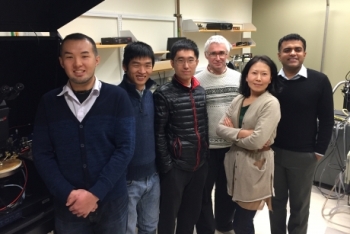Jan 20 2016
Cornell engineering professor Huili (Grace) Xing and her research team aim to be successful in making smaller switches perform large jobs in a more efficient way than currently possible.
 From left, researchers Kazuki Nomoto, Bo Song, Zongyang Hu, Vladimir Protasenko, Grace Xing and Debdeep Jena are pictured in Xing’s Phillips Hall lab. On the left is the High Power Device Probe Station, where results of the team’s gallium nitride experimentation were analyzed. (Tom Fleischman)
From left, researchers Kazuki Nomoto, Bo Song, Zongyang Hu, Vladimir Protasenko, Grace Xing and Debdeep Jena are pictured in Xing’s Phillips Hall lab. On the left is the High Power Device Probe Station, where results of the team’s gallium nitride experimentation were analyzed. (Tom Fleischman)
Xing and her team have developed gallium nitride (GaN) power diodes used as the building blocks for future GaN power switches. A GaN power-switching device, supporting 2,000 volts of electrical power, was built by the group. This device is roughly one-fifth the width of a human strand of hair.
GaN is used in electricity distribution infrastructure and a wide range of electronic products. In the future, GaN will have a major role in power conversion and control.
With some of these new materials, it’s actually conceivable now to shrink medium-scale power-distribution systems onto a chip. Looking into the future, this is one of the goals, and it’s not a moonshot. It’s possible, but the materials have to be right, the design has to be right.
Debdeep Jena, Engineering Professor, Cornell University
The Cornell team’s research was published in the Dec 15th issue of Applied Physics Letters, a publication journal of the American Institute of Physics. The group includes researchers from Cornell, the University of Notre Dame, and the semiconductor company IQE.
When compared with traditional silicon-based substrates, this team have constructed a power-switching device on a GaN base layer comprising of very few energy-sapping defects.
We’re going to take the defects, some of them anyway, out of the equation. Nothing can be 100 percent [free of defects], but we’re talking about improvements along an order of magnitude of up to 10,000 times.
Huili (Grace) Xing, Professor of Materials Science and Engineering, Cornell University
Certain indicators were used to check the defects in the GaN diode and the “diode ideality factor” as measured by the Shockley-Read-Hall recombination lifetime, which is the average time it takes to move negatively and positively charged particles, before recombining at defects leading to inefficiency.
The outcome of the team’s research has enhanced the performance and provided hope for the progress of GaN power diodes.
Our results are an important step toward understanding the intrinsic properties and the true potential of GaN.
Zongyang Hu, a Cornell Postdoctoral Associate
The team’s effort in working towards power transmission is equally important to the amount of energy-related research concentrating on alternative sources of energy like solar and wind.
Power generation gets a lot of press, and it should. But once the power is generated, the amount of power that is lost because of inefficiencies is mind-bogglingly large. This problem is about conservation rather than generating power, which is really the same thing. And the scale of losses today actually far surpasses the total of renewable energies combined,” he said. “And it’s a clear and present solution; it’s not like we have to discover something fundamental.
Zongyang Hu, a Cornell Postdoctoral Associate
The team’s work is supported in part by the U.S. Department of Energy’s Advanced Research Projects Agency-Energy (ARPA-E) “SWITCHES” program. SWITCHES stands for Strategies for Wide Bandgap, Inexpensive Transistors for Controlling High-Efficiency Systems.
“Leading one of these projects, we at Cornell – in collaboration with our industrial partners – have established an integrated plan to develop three terminal GaN power transistors, package them, and insert them into circuits and products,” Xing said.
The team’s paper is titled “Near unity ideality factor and Shockley-Read-Hall lifetime in GaN-on-GaN p-n diodes with avalanche breakdown.” Cornell collaborators included Kazuki Nomoto and Vladimir Protasenko, visiting professors in the School of Electrical and Computer Engineering, and graduate students Bo Song and Mingda Zhu. The team also included Jena’s Ph.D. student Meng Qi at the University of Notre Dame, and engineers Ming Pan and Xiang Gao of IQE.